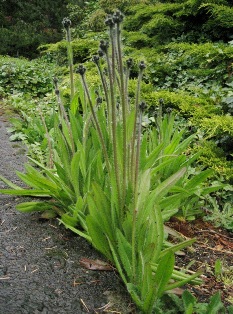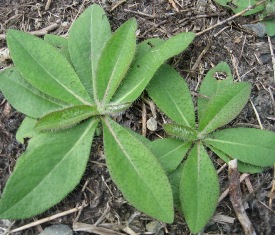June 26 - Summer has arrived. We had a beautiful Full Strawberry Moon on June 24th. Summer memories always revolve around nature's aromas and scents. One plant that you wouldn't think contributes to a flowery essence is the common privet hedge - Ligustrum ovalifolium. When you study & memorize the phenology of a garden, if you ever became deaf & blind, you'd always know when the seasons come and go by the fragrance in the garden. You'd learn that Spring is over when the wild roses stop blossoming, and that summer is here when the wild privets are in full blossom. The fragrance of these small, seemingly insignificant flowers is a trademark of summers on Long Island. If you take the time to sit in nature by the untrimmed, wild privets growing in your yard like I do, memories of childhood summers most surely will flood your thoughts. A great shrub to attract bees. The entire yard is intoxicatingly fragrant, today. I am remembering my adolescence living on Jackson Ave. in Lindenhurst, and walking along Copiague Road toward Zahns Airport in Lindenhurst and smelling these flowers that filled the air with summer's perfume. And while walking from the small airport, I searched the ground for yellow buttercups to hold underneath my brother's chin to test whether he liked butter. Ahhh the memories of a childhood out in nature. Priceless!
A journey through the changing seasons of my organic Long Island Garden.
Saturday, June 26, 2021
Sunday, June 13, 2021
Triodanis Biflora - June in the organic Gardens.
It's a delightful cool Sunday morning - 62 degrees and no wind. A perfect day to burn these piles of wood. While I tend to 2 burning pits and use the chain saw and pruners to make smaller pieces to burn, I can clean up and trim, rake and tidy up the north organic gardens. There's a special plant I've been observing and want to share info on it, this morning. It's Native to America and so sweet and clean cut, upright, and interesting to look at.
Today I saw the very first dark purple flowers open up. But only on the top of the plant. I love it's cupped leaves. It's got a strong stem and is upright, but still small and dainty.Blooms in various stages of development. Today there are the first purple blooms coming out and they are on the top of the slender plant.
Triodanis perfoliata is native to the United States and Canada. This species grows in all of the lower states in the United States except Nevada; it also grows in British Columbia, Ontario, and Quebec.
Tridanis biflora is also native to the United States but only grows in the lower U. S. from Oregon and California through Arizona and New Mexico. It also grows in states south of and including Nebraska, Missouri, Illinois, Kentucky and Virginia as well as in New York State and Pennsylvania.
Monday, June 7, 2021
A sunny hot Monday, June 7, 80 degrees and very humid. I observed many many yellow flowers on tall firm stems. Yellow Hawkweed. It's growing in clusters so no fescue grass can grow. I need to dig them out.
Hieracium caespitosum

Yellow hawkweed has clusters of many small, yellow dandelion-like flower heads on top of mostly leafless stems. The erect, bristly stems can grow up to 3 feet tall, each topped by 5 to 30 bright yellow flower heads in a compact, flat-topped cluster. Each plant produces 10 to 30 flower stems. Flowers in bud are distinctively rounded and black-hairy in tight clusters at the tops of the stems.
The leaves are long and narrow, up to six inches long, not lobed, somewhat hairy on both sides, and form a basal rosette. There are also usually one or two small leaves on the stem. The entire plant contains a milky juice. Yellow hawkweed has a shallow root system and underground creeping stems called rhizomes. New plants can arise from buds on the rhizomes and plants can develop several creeping stems (like strawberries) that are also capable of producing new plants.

Yellow hawkweed is a perennial and spreads by seeds, stolons and rhizomes. It flowers from mid-May to July and usually sets seed by August. Yellow hawkweed thrives in disturbed areas such as roadsides, gravel pits and pastures. It can also invade meadows and forested areas and is well-adapted to life at higher elevations. Usually found in sunny areas, it is somewhat shade tolerant.
Hawkweed identification can be difficult and often requires technical details such as hair types. Also, hybridization between species can make it even more confusing.
Thursday, June 3, 2021
So it's already June and still light at 8:20 PM when the sun sets. Sunrise is 5:24 AM. The white Spirea has all faded as has the dogwood bracts. Forsythia are long gone and desperately need to be pruned. Mom's old climbing rose is in blossom and so is the black locust tree. The invasive blackberry brambles have white flowers, and the golden raspberries are getting ready to bear fruit. The lily of the valley was quick to fade from their intoxicating fragrance and now the honeysuckle have taken over the perfume counter in the landscape. Shocked to see it wound all around the hedgerow. This could be serious. The fragrance reminds me of my Grandmother. I had to pick a bouquet. Amazing how the scent of a flower can transport you back into time and associate your memories to a loved one from your past or a lazy summer day in nature.
And tonight I want to write about the Japanese Honeysuckle plant. Did you ever notice or wonder why there are different colors on one vine? When the honeysuckle flowers are white, it is their first day blooming. The next day they begin to turn light yellow, and by the third day they are darker yellow. Insects prefer colors rather than white flowers. And with honeysuckle, there is an indication that inside the yellow flowers there's nectar in it's corolla (nectar tube), and it immediately needs pollination to occur.
So as you study Phenology, stop and observe if bees and butterflies are landing on the yellowing honeysuckle flowers or the white.
And remember, any plant that has a name starting with a foreign country, don't plant it in your garden. Now's a good time to find the Japanese honeysuckle vines and get them out of your shrubs that have stopped blooming. You can see the invasive honeysuckle clearly by those sweet delicious flowers dancing all over your stately shrubs. How many of you were taught to pick a flower and suck on some sweet nectar as a child?
Carefully pull on the end of the flower. A white "string" should show up, connected to the calyx. This white "string" is the style, part of the female half of the flower. Continue to slowly pull the style down the center of the flower. Luckily, the style has a little green plunger on the end of it (called the stigma) that just barely fits into the tube shaped flower, forcing all the nectar to pool in a little drop at the back end.
Bring it to your lips, and enjoy!
Hibernating During the Dreary Days of February of 2025
All the major holidays have passed offering relief and reprieve from all expectations or disappointments. Weather is a winter of chilly da...
.JPG)
-
All the major holidays have passed offering relief and reprieve from all expectations or disappointments. Weather is a winter of chilly da...
-
https://youtu.be/pY_M-1dntLk There is love within everything created on this Earth.
-
Acer saccharinum One of the most common trees you may encounter near water is known as Silver Maple. Readily identifiable in Summer by it’s...











.JPG)

